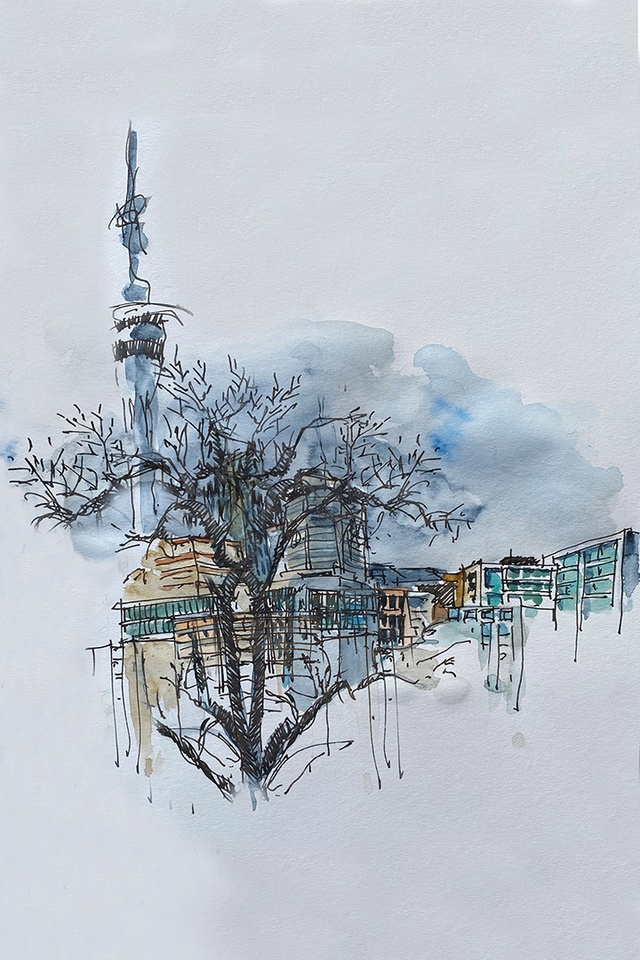The good, the bad and the ugly
Pip Cheshire advocates for greater diversity and inclusivity in the design and planning of architecture in our cities.
I have to concede I have a fairly facile view of the ground plane. It may be that it bears the burden of my inefficient means of perambulation, anything other than a flat surface mounting a challenge to my forward motion, slopes and hills, in particular, being a damn nuisance. Even a flat plane may conceal incipient impediments: small variations to catch a lazy heel or more substantial changes in plane that require a break in step to ensure my ‘good leg’ is the first to land. If this were a particular response of monopods only, I would feel slightly aggrieved and treat it as yet further evidence of a malign universe. I received, though, some affirmation of the inherent untrustworthiness of landforms when, years ago, I was first asked to build on a clifftop.
I had called upon the services of a geotechnical engineer to describe the risks and methods for overcoming them. I anticipated a fairly prosaic reading of slip planes, slope analysis, a brief overview of the site’s geomorphology and advice as to the nature of foundations for the project to be. What I and the bemused client received was lyrical discourse on the impermanence of landforms in general and this one in particular. The lesson, for that was what it was, was delivered by our genial consultant with one foot on the clifftop escarpment and one on an elderly pine perched precariously on the precipitous drop which it seemed to be holding together. His soliloquy ended with the advice that all slopes were destined to fall to level and this one, in particular, more eager than most. It was a revelation: the cliff that I had so recently thought of as endowing a magnificent unobstructed view transformed at a clap into a malevolent presence.

The transformation of land from picturesque idyll into lifethreatening foe is, alas, alarmingly familiar to those whose homes have been rendered uninhabitable by the assaults of relentless rainstorms that seem to be our ‘new normal’ as the calamitous effects of climate change surely convince even the most pigheaded of deniers. Glenn Murcutt has always spoken about the importance of understanding a site’s hydrology before picking up a pencil. This concern has seemed strange in a land more prone to fire than water, though the huge Queensland floods of early 2022 produced scenes of devastation that we have become used to in the northern half of our country.
The reading of land, be it to understand the potential for surging inundation or the retreat of a clifftop, is more complex than any amount of my invective against sloping land might suggest. I was reminded of this not long ago when a number of us travelled into the Far North to review some land that had been proposed for house lots. We were five strong: a landscape architect, a geotechnical engineer, an ecologist, a planner, an archaeologist and myself, each having a particular engagement and, as it transpired, a distinct body language as we squinted, sketched and surveyed our way around the vast, rolling landscape.
In comparison with the focused observations of my fellow travellers, I felt I worked rather haphazardly, feeling the inclination of my ankle as I teetered on the steeper land, the breeze upon my back as I moved up and over the crest of a ridge, the rotation of my neck as I scanned the curve of the horizon. I measured the slopes, found north, the rise of winter sun and sketched as fast as I could. The others saw things I didn’t see or, rather, saw but didn’t understand the import of: a slight slumping in the ground suggesting a midden, a broken contour signalling a slope failure, or some barely discernible tracks across a puddle’s muddy curtilage heralding an occupation below our feet. The landscape architect, though, had a unique perspective, viewing the site as if in a mirror, imagining himself looking at the site from afar, gauging the impact of a future building, and proposing a planting regime to ensure that any built form near a skyline would be seen with a backdrop of trees.
Oh, that we might approach the city with a similarly focused strategy, but maybe not so singularly pragmatic as our northern gang. Might we leaven the mix with a wider range of enthusiasts: skaters, tree-huggers, denizens of the night, the elderly and infirm, and perhaps some of Chaucer’s fellow travellers along too? Surely, our understanding of the necessary corrections our cities require would be greatly informed by the presence of a reeve, a squire or a miller, and who could pass up the wife of Bath’s tale as we traverse High Street? In an age so enthusiastically embracing inclusiveness, what could be better than an elderly fellow citizen testing Zimmer frame access to a flash harry main-street joint selling geejaws?

I have my doubts that this might come about. Despite the rates-induced purging up here in the north and the Wellington cabal laying siege to our unitary plan, city hall still has a long reach and a swag of bureaucrats with undue faith in the power of planning documents to deliver a half-pie-decent city. The curse is that those poring over city plans have to deal with the avaricious, who see the city as only a place from which to extract dough. Attempts to curtail their excesses inevitably frustrate the best intentions of those landowners and developers who seek to reconcile making a bob with leaving the world a better place than they found it. The result is, inevitably, mediocrity.
The city’s rooftops are a fine example of the confluence of planning constraints and an investment industry founded on the indisputable reading of a property’s development opportunity, measured to five decimal points of accuracy in conformity with the property council’s measuring schema. Where this and the planning controls are all that is in play, the consequence is development maxing out the allowed floor area ratios producing a city that has a near-uniform height. There are a few exceptions: sites along the waterfront where the city plan allows buildings more suggestive of a mohawk or those fascinators favoured by royal princesses than the uniform GI Joe buzzcut that mid and uptown buildings affect.
The city’s Urban Design Panel has attempted to arm planners with tools to rebuff developers seeking to drive up the nett lettable. We have argued for an extra half floor for a sculptured rooftop plant room, penthouse or garden bar, or a loosening of the controls in exchange for an exquisite street presence perhaps. My spirited exhortations in this respect when I sat at that forum appear to have had little effect, as yet another flat-top structure appears on my immediate horizon, victim of an apparatus too gun-shy to enter into the capricious realm of making qualitative decisions with the lurking threat of judicial review of Council’s right to make such subjective calls.
I understand and empathise with those caught in the no man’s land between aggressive developers and bleeding-heart aesthetes lobbying for a more civilised city. Perhaps we might call on that inclusive band of analysts we left on High Street to arbitrate who gains another few metres of GFA. Time to bring the Zimmer frames and skateboards up to the 10th floor and let them have a crack at sorting out the good, the bad and the ugly; no rules seem to be delivering the goods at the moment.










